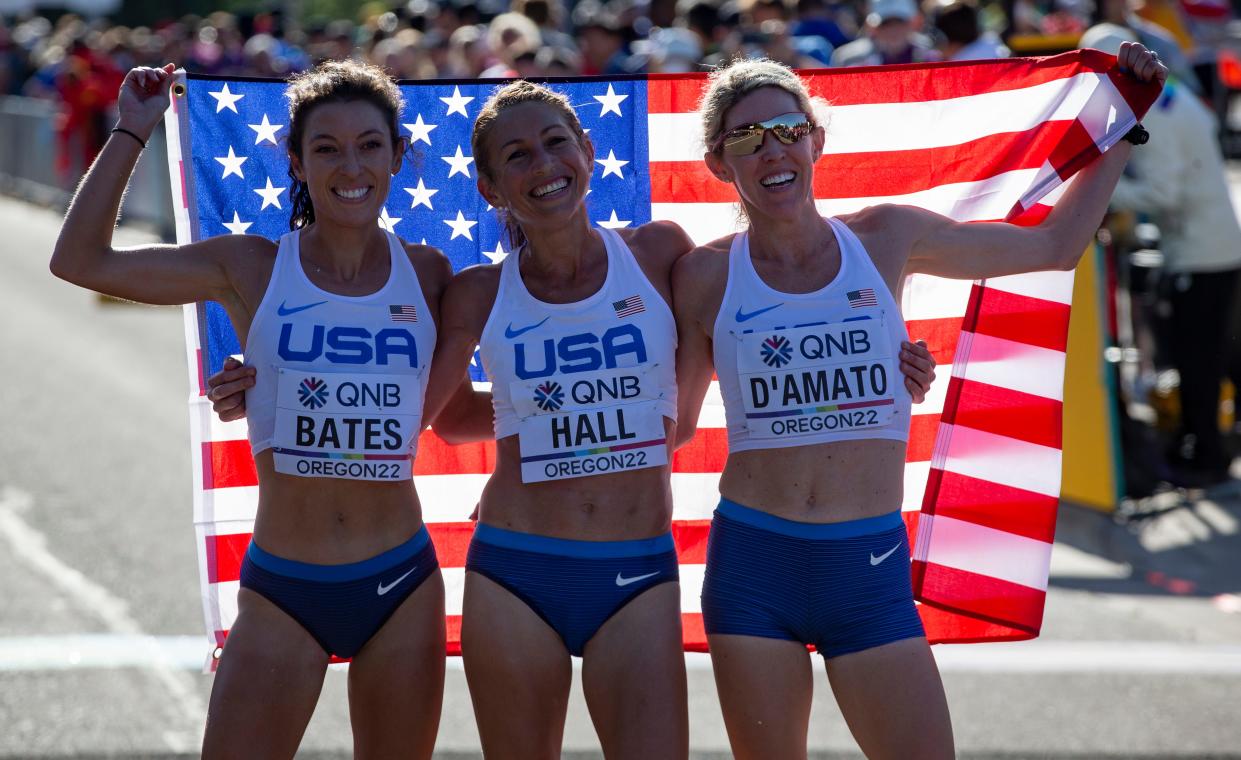Female athletes get fewer full-ride scholarships, absorb more student debt, than males

- Oops!Something went wrong.Please try again later.
Within three years of finishing college, Emma Bates was the best female marathoner in the United States. She won the national title in 2018 and was third at the half-marathon championships in 2019. She made her major marathon debut later that year, in Chicago, and finished fourth.
With the Tokyo Olympics fast approaching, Bates was well on her way to being the new face of U.S. distance running.
She also was essentially living in poverty.
Despite being a full-time Division I student-athlete, Bates had only a partial scholarship for her first three years at Boise State. Her parents weren’t in a financial position to help her make up the difference, and she now found herself saddled with about $10,000 in debt.
She worked 60 hours a week at two jobs, as a nanny and as a cashier at Whole Foods, while running 100 miles a week training to try and make the Olympics.
“I was struggling immensely, living in Boston, trying to pay rent, let alone student loans,” Bates said of those first years out of college. “I wasn’t eating well, I was so stressed about that debt. … I didn’t do anything except work and run for a few years.”
“That’s the whole facade of it — you hear if you’re good enough to make it to D-I, you’ll be taken care of,” Bates said.
Read the full investigation: Female athletes stiffed on scholarships at some of the biggest colleges in the country
Don’t athletic scholarships provide a 'full ride'?
Not all of them.
In the NCAA's Division I, the highest level in college sports, schools offer two types of athletic scholarships: Headcount and equivalency. A headcount scholarship is what’s traditionally known as a “full ride,” covering tuition, books, fees, as well as room and board and incidentals. But it’s only offered for a few sports – Bowl Subdivision football, men’s and women’s basketball, and gymnastics, volleyball and tennis for women – and can only be given to a specific number of athletes on a roster.
The remaining sports get equivalency scholarships, or partial scholarships. Each equivalency sport is granted a specific number of scholarships, and a coach can divvy up the funds however he or she sees fit. One athlete might get a full ride, while another might get enough to cover tuition, while still another might only receive enough for books.
How does this create inequity?
Title IX, the federal equity in education law, requires that schools distribute scholarship money equitably among male and female athletes. The Office of Civil Rights, the agency inside the U.S. Department of Education that is tasked with enforcing Title IX, considers schools to be compliant if they’re allotting their scholarships within 1% of the share of athletes for each sex. So if women are 45% of a school’s athletes, that school must provide between 44-46% of its scholarship dollars to women.
A USA TODAY analysis of scholarship data across the 107 public schools in the NCAA's Football Bowl Subdivision found just 32 schools met federal requirements while 49 were not giving women athletes the appropriate amount in scholarship money.
How much money are we talking about?
Across the FBS schools analyzed by USA TODAY, female athletes were shortchanged a total of $23.7 million.
The schools that underfunded women were so far below that 1% window that they would have to spend an average of almost $483,000 per school just to be compliant with Title IX.
That's on top of the fact that most FBS schools don't give women enough athletic opportunities to begin with. According to an earlier USA TODAY investigation, 87% of 127 public and private colleges and universities in the FBS don't offer women athletic opportunities proportionate to their enrollment.
So women are being short-changed both in the number of roster spots available and in the scholarships that come with them.
What do the schools say?
Boise State, Bates’ alma mater, and Georgia State admitted they were not in compliance, blaming it on an NCAA rule that gave some students an extra year of eligibility because of COVID. New Mexico, Ohio University and the University of Nevada said their gaps – all greater than 4.5 percentage points – were explained by permissible, non-discriminatory reasons.
South Florida, Central Michigan and New Mexico State did not dispute being out of compliance, but offered no explanation. San Diego State, Utah State, Miami University in Ohio, Appalachian State and Bowling Green did not respond to multiple emails. Minnesota asked for more time but then did not respond.
Why is this a big deal?
Aside from it being discriminatory, it can exacerbate a student debt crisis that disproportionately hurts women.
Women hold about two thirds of the country’s $1.7 trillion in student debt. And, according to The Education Trust, Black women carry about 20 percent more in debt than white women, at an average of almost $39,000.
This results in women putting off home ownership and saving for retirement, leaving them financially strapped long after they have left school.
“Growing up, all my mama talked about was how she wouldn’t wish college debt on her worst enemy,” Shamier Little, one of the few track athletes who had a full scholarship when she ran for Texas A&M University from 2013 to 2016.
Read the full series: Title IX: Falling short at 50
This article originally appeared on USA TODAY: Even for the best female athletes, full-ride scholarships are scarce

